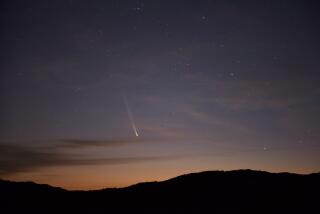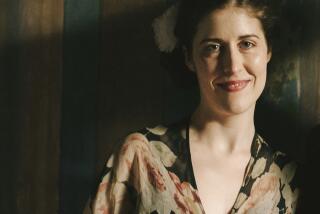A Look Skyward at Halley’s Comet : Griffith Observatory Prepares for a Celestial Visitor
The comets were at any time
Signs of God’s ire and signify
Storm, famine, plague and heavy floods;
Earthquakes and changes, Death of Lords.
--17th-Century German hymn
While most of the mysticism and terror that surrounded the appearance of comets in earlier times has been dissipated by greater scientific knowledge today, public wonderment over these periodic celestial visitors endures.
Today, the most famous of these interplanetary streaks of ice and dust, Halley’s Comet, is practically at the Earth’s doorstep, hurtling toward the planet at about 120,000 miles per hour. About 277 million miles away from the Earth at the beginning of September, it will close to 148 million miles away by Oct. 15.
There are few places where the comet discovered by Edmond Halley (pronounced like “galley,” not like “gaily”) will flash more brightly into the public consciousness than at the Griffith Observatory.
“Comet season opens today,” said E.C. Krupp, the observatory’s director, on Wednesday. The opening of a new planetarium show, “Comet Halley’s 1986 World Tour,” coincided with the Sept. 11 flyby of the International Comet Explorer spacecraft past the Comet Giacobini-Zinner.
The Human Bond
Krupp said that in its planetarium show and other Halley-related activities, the observatory will stress the human bond with Halley’s Comet that has made its appearance eagerly awaited throughout the years.
“You hear about Halley’s Comet when you are a child and learn that it comes back every 76 years,” Krupp said. “Everyone hears that and calculates how old they will be when it returns.”
“Comet Halley is a once in a lifetime experience,” said Stephen Cooperman, a staff lecturer at the observatory. “It binds us to our ancestors.”
According to John Mosley, program supervisor at the observatory and producer and writer of the planetarium show, it is the “linking of generations”--tales of sightings handed down from parent to child--that make the comet’s appearance meaningful to the mass public, not its brightness in the sky.
“You don’t see New Year’s Eve, but you celebrate its passage because you know it’s there,” said Mosley, who first began to think about the comet’s 1985-86 appearance nearly 30 years ago when he was nine years old.
The upcoming passage of the comet will be less spectacular than it was in 1910 because it is not coming as close to the Earth on this trip, according to Mosley. “It will not be served up on a platter,” Krupp said.
The comet will not be visible from Los Angeles because the city lights bleach out the sky, making faint objects, such as comet tails, impossible to see. “If you can’t see the Milky Way, you won’t be able to see the comet,” Mosley said.
Contrary to popular opinion, the problem of lights obscuring Halley’s Comet is not unique to the current passage. Wrote E. E. Barnard, a foremost authority on Halley’s Comet during its 1910 passage, in the Astrophysical Journal of June, 1914: “The great cities that have grown up since 1835, and the smoke and electric lights of today completely robbed the comet of its glory when seen by dwellers in and near the centers of population.”
Compared with earlier times, the world of 1910 took a fairly sanguine attitude toward Halley’s Comet. Although some authorities warned that the Earth could be contaminated by poison gases from the tail of the comet (a fear that some hucksters profited from by selling comet pills to worried citizens), many others celebrated the comet’s appearance.
A “Halley’s Comet Rag” was composed, the Ziegfeld Follies developed a comet dance and plush hotels across the United States and Europe celebrated by holding rooftop comet parties.
In earlier days, comets were considered omens, usually of natural disasters or the death of kings.
Said the Chroniques de l’Oeil-de-Boeuf of the Comet of 1680: “While the fearful are making their wills and leaving their goods to the monks in expectation of the end of the world, there is high agitation at the court on the question as to whether this wandering star has not come to announce the death of some great personage.”
Said an anonymous chronicler of the Comet of 837, which came during the reign of Louis the Debonir of France: “A phenomenon which is always ominous and a carrier of bad news appeared in the sky. As soon as the emperor, who always had paid attention to such events, had noticed it, he allowed himself no rest.
“ ‘A change of reign and the death of a prince are announced by this sign,’ he told me. He consulted the bishops, who advised him to pray, build churches and found monasteries. Which he did. But he died three years later.”
Mosley said the planetarium show is also a tribute to Halley, who also prepared the first star charts of the southern sky, tested the first underwater diving bell, developed the first annuity tables, discovered the distance between the Earth and the Sun, and invented weather charts.
“Edmond Halley’s greatest contribution was not in predicting this particular comet, but in making the arrival of comets in general predictable,” Mosley said.
Other Halley-related events are planned. The observatory is already preserving materials related to the comet’s 1985-86 passage for 2061, its next appearance. The time capsule, which will not be opened until then, will have “letters to the future” written by schoolchildren and contemporary comet-related memorabilia.
‘A Good Display’
“I think it will make a good display,” Mosley said. “Whoever has my job in 2061 will be pleased.” The time capsule will be sealed on April 11, a date when the outbound comet will be a mere 39 million miles from the Earth, the closest it will get.
Also going into the time capsule will be photographs of some local children younger than 10 years of age. Krupp said “first-timer” certificates will be handed out to the children, who are invited to visit the observatory to see the comet again in 2061.
At the other end of the life cycle, on Nov. 13 the observatory will host a meeting of “two-timers,” persons who saw the comet in 1910.
For everyone in between, Halley’s birthday will be celebrated on Nov. 8 on the roof of the observatory (currently closed for cleaning of the copper domes), complete with birthday cake and chamber music. On Nov. 27, when the comet will be the closest to the Earth on its inbound passage, a free bottle of “comet pills” will be given to the first 50 persons to attend each planetarium show. On Jan. 3, 1986, there will be “a big comet party,” Krupp said.
On perhaps a more serious note, a seven-part Monday night lecture series called “Off on a Comet” will be held from Sept. 30 to Dec. 2. A Halley’s Comet exhibit will go on display in the observatory’s Hall of Science in November.
The planetarium show will run through Dec. 8, when the observatory’s annual Christmas show begins. “Comet Halley’s 1986 World Tour” will resume Dec. 31 and run through April 1986. Admission is $2.50 for adults and $1.25 for children 5 to 15 and for seniors 62 and older.
Despite all these comet-related activities, Krupp stresses that there is no substitute for going away from the city lights on a clear, moonless night with a good pair of binoculars to see the real comet, not the facsimile projected on the planetarium dome.
“You didn’t see it if you saw it here,” Mosley said. “But you’re prepared to see it.”
More to Read
Sign up for The Wild
We’ll help you find the best places to hike, bike and run, as well as the perfect silent spots for meditation and yoga.
You may occasionally receive promotional content from the Los Angeles Times.






